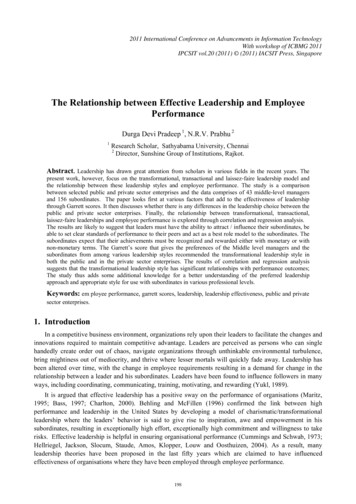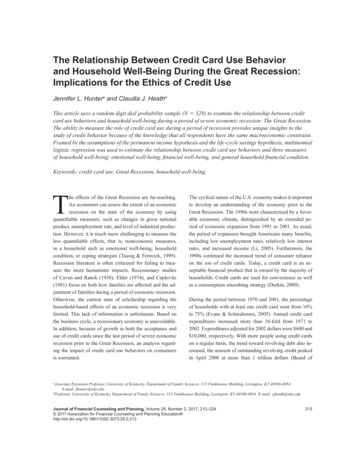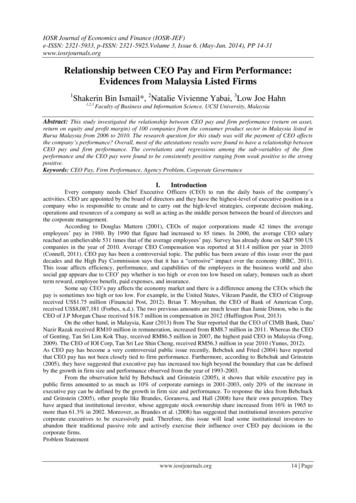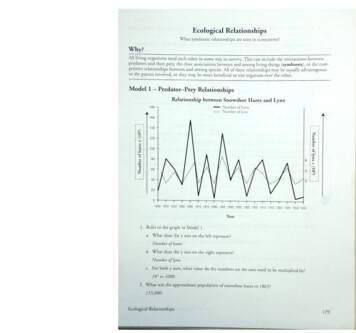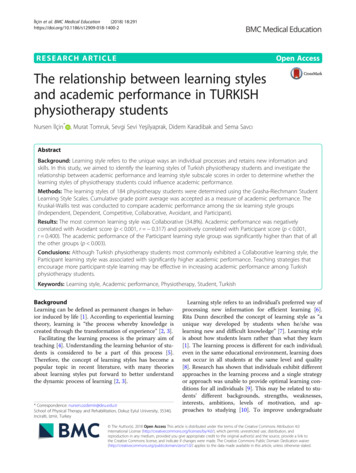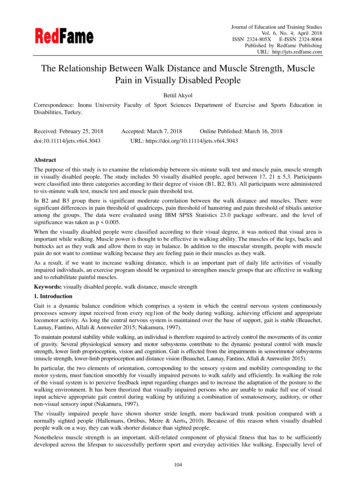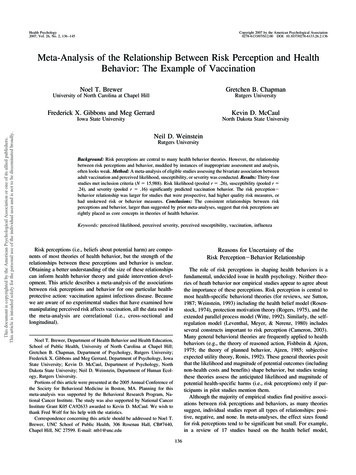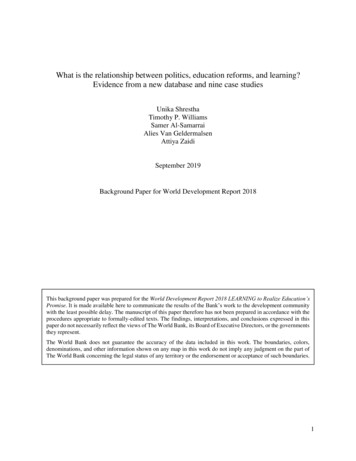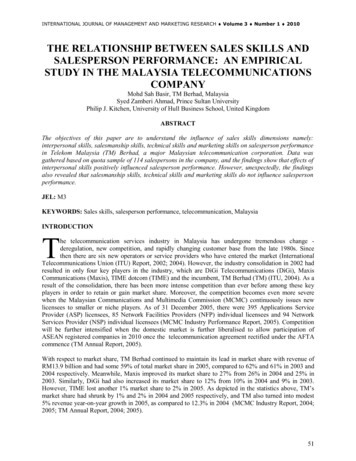
Transcription
THE RELATIONSHIP BETWEEN PERCEIVED SERVANT LEADERSHIPCHARACTERISTICS, HUMAN RESOURCE PRACTICES ANDTURNOVER INTENTION IN SMALL MEDIUM ENTERPRISESNG XIN LEUNIVERSITI TEKNOLOGI MALAYSIA
THE RELATIONSHIP BETWEEN PERCEIVED SERVANT LEADERSHIPCHARACTERISTICS, HUMAN RESOURCE PRACTICES AND TURNOVERINTENTION IN SMALL MEDIUM ENTERPRISESNG XIN LEA thesis submitted in fulfilment of therequirements for the award of the degree ofDoctor of Philosophy (Management)Faculty of ManagementUniversiti Teknologi MalaysiaMARCH 2018
iiiDedicated to:my beloved parents Ng Kam Boon and Fong Ting Choo,my sister Ng Xin Ying,my brother Ng Jing Yi, andmy lovely cousin Lee Ruo Lynn.
ivACKNOWLEDGEMENTSI would like to express my sincere appreciation to Associate Professor Dr.Choi Sang Long and Dr. Khairiah Soehod for their kind supervision. It is has been agreat honour to work under them. Their constant tutelage and helpful guidance haveenabled me to benefit much.This study would not have been possible without support from thosesurrounding me. My sincere thanks go to my friends, Dr. Thoo Ai Chin, Ms. YeongSook Shuen, and Mr. Chua Jing Lun. I very much appreciate their patience andwillingness to discuss the analysis with me. I will never forget our moments ofcollective joys and of shared sadness throughout this program. My acknowledgementalso goes to all who helped me during the data collection and to the respondents inthis research.Last but not least, I want to extend my love and appreciation to my belovedfamily members, especially my father Ng Kam Boon, mother Fong Ting Choo,siblings Ng Xin Ying and Ng Jing Yi, and my adorable cousin, Ruo Lynn: they haveall been the indispensable motivational force with which I have completed thisscholarly journey. Thank you and I love you all.
vABSTRACTEmployees’ turnover intention is one of the challenges faced by manyorganisations including small medium enterprises (SMEs) in Malaysia. Thus,demand for an effective leadership style is crucial as it can increase employees’interest to stay longer in organisations. The relationship between leadership stylesand employees’ turnover intention has been widely studied. There are variousleadership styles such as transformational, transactional, autocratic and charismaticleaderships. While the concept of leadership has been extensively studied, the role ofservant leadership in reducing employees’ turnover intention has not been fullyunderstood. Servant leadership focuses on their followers’ needs in establishing goodrelationship with followers. In addition, it is associated with characteristics such asstanding back, empowerment, ethical, humility, listening and forgiving. This studyexamined the relationship between servant leadership (independent variables) andemployees’ turnover intention (dependant variable). In addition, this studyinvestigated the effect of human resource (HR) practices as the mediating variablesince this relationship has received scarce attention in research. HR practices such astraining and development, rewards and pay system, performance management, andoccupational safety and health management were the focal points of this research.The objectives in this research were to identify the level of servant leadership inSMEs; to investigate which is the most frequently used HR practices; to determineinter-relationships between servant leadership, HR practices and turnover intention;and to examine the role of HR practices as a mediator. Using questionnaires, datawere collected from 227 local SMEs' employees in manufacturing sector. Thequestionnaires were distributed by hand, mails, emails and Google Forms. SPSSversion 24 was used to analyze the normality test and demographic factors of therespondents, whereas AMOS version 24 was used for Confirmatory Factor Analysis(CFA) and testing the relationship between variables in the Structural EquationModeling (SEM). The results showed that the level of servant leadership is moderateand performance management is most frequently used HR practices among SMEs.Apart from that, it was found that there is a significant positive relationship betweenservant leadership and HR practices, in which good servant leadership and HRpractices are found to be significant in reducing employees’ turnover intention. It isdiscovered that only two dimensions of servant leadership which are listening andethical behavior showed a significant mediation effect on turnover intention. In short,these findings provided useful insights for practitioners of SMEs in reducingemployees’ turnover. It is recommended that leaders not only have to listen to theneeds of their employees but to take care of their welfare such as trainingopportunities and pay rates.
viABSTRAKNiat pusing ganti para pekerja merupakan salah satu cabaran yang dihadapioleh pelbagai organisasi termasuk perusahaan kecil dan sederhana (SME) diMalaysia. Oleh itu, permintaan untuk gaya kepimpinan yang efektif sangat pentingbagi menarik minat para pekerja untuk terus berkhidmat dalam organisasi. Hubungkait antara gaya kepimpinan dan niat pusing ganti para pekerja telah dikaji secarameluas. Terdapat banyak jenis gaya kepimpinan seperti kepimpinan transformasi,transaksi, autokratik dan karismatik. Walaupun konsep kepimpinan telah dikajisecara mendalam, peranan kepimpinan hamba (servant leadership) bagimengurangkan niat pusing para pekerja belum difahami sepenuhnya. Kepimpinanhamba memberi fokus kepada keperluan pengikut dalam mewujudkan hubunganyang baik dengan pengikut. Tambahan lagi, ia dikaitkan dengan ciri-ciri sepertimelangkah ke belakang, pemerkasaan, beretika, merendah diri, mendengar danmemaafkan. Kajian ini meneliti hubungan antara Kepimpinan Hamba (pembolehubah bebas) dan niat pusing ganti para pekerja (pemboleh ubah bersandar). Selain itu,kajian ini juga mengkaji kesan amalan sumber manusia sebagai pemboleh ubahperantaraan kerana hubungan ini tidak begitu diberi perhatian dalam kajian. AmalanHR seperti latihan dan perkembangan, sistem ganjaran dan bayaran, pengurusanprestasi, serta pengurusan keselamatan dan kesihatan pekerjaan merupakan titikfokus kajian ini. Objektif kajian ini ialah mengenal pasti tahap kepimpinan hamba diSME; mengkaji amalan HR yang paling kerap digunakan; menyelidik hubunganantara kepimpinan hamba, amalan HR dan niat pusing ganti; dan menyelidik perananamalan HR sebagai perantara. Dengan menggunakan borang soal selidik, data telahdikumpul daripada 227 pekerja SME tempatan dalam sektor pembuatan. Borang soalselidik telah diedarkan secara terus, melalui surat, email dan borang Google. SPSSversi 24 telah digunakan untuk menganalisis ujian kenormalan dan faktor demografipara responden, manakala AMOS versi 24 telah digunakan untuk Analisis FaktorKonfirmatori (CFA), dan menguji hubungan antara pemboleh ubah dalamPermodelan Persamaan Berstruktur (SEM). Keputusan menunjukkan tahapkepimpinan hamba adalah sederhana dan pengurusan prestasi merupakan amalan HRyang paling kerap digunakan di SME. Selain itu, didapati bahawa adanya hubunganpositif yang signifikan antara kepimpinan hamba dan amalan HR, dan kepimpinanhamba dan amalan HR yang baik didapati secara signifikan menurunkan kadar niatpusing ganti para pekerja. Didapati juga hanya dua dimensi kepimpinan hamba iaitumendengar dan perlakuan beretika menunjukkan kesan perantaraan yang signifikanterhadap niat pusing ganti. Jelasnya, dapatan kajian ini memberikan pemahamanbermanfaat kepada pengamal SME untuk mengurangkan pusing ganti para pekerjamereka. Adalah dicadangkan agar pemimpin bukan sahaja perlu mendengarkeperluan pekerja mereka tetapi juga menjaga kebajikan mereka seperti peluanglatihan dan kadar bayaran gaji.
viiTABLE OF OWLEDGEMENTivABSTRACTvABSTRAKviTABLE OF CONTENTSviiLIST OF TABLESxiLIST OF FIGURESxvLIST OF ABBREVIATIONSLIST OF n11.2Background of the Research21.3Problem Statement91.4Research Questions131.5Research Objectives131.6Scope of the Research141.7Significance of the Research151.8Conceptual and Operational Definitions161.8.1 Servant Leadership161.8.2 Human Resource Practices171.8.3 Turnover Intention171.8.4 Small Medium Enterprises181.8.5 Skilled Employees18Summary191.9
viii2LITERATURE REVIEW202.1Introduction202.2Background of Manufacturing SMEs in Malaysia212.3An Overview of Leadership272.4Comparison of Various Leadership Styles302.5Servant Leadership362.5.1 Criteria in Servant Leadership452.5.2 Summary for Servant Leadership54HR Practices542.6.1 HR Management Model572.6.2 Summary for HR Practices68An Overview of Turnover and Turnover Intention692.7.1 Impacts of Turnover and Turnover Intention692.7.2 Models of Turnover722.62.72.8Previous Studies on Relationship between ServantLeadership Style and HR Practices2.978Previous Studies on the Relationship between HR Practicesand Turnover Intention2.1083Previous Studies on Relationship between ServantLeadership Styles and Turnover Intention2.1187Previous Studies on the Relationship between ServantLeadership, Employee Turnover Intention and HR Practices3as a Mediator932.12Social Cognitive Theory as Underpinning Theory952.13Theoretical Gap of the Study962.14Research Framework99RESEARCH METHODOLOGY1013.1Introduction1013.2Research Process1013.3Research Design1043.4Population and Sampling1053.5Data Collection1083.6Development of Research Instrument108
ix43.6.1 Measurement for Respondents' Demography1093.6.2 Measurement for Servant Leadership Styles1103.6.3 Measurement for Human Resource Practices1143.6.4 Measurement for Turnover Intention1183.7Translating Research Instrument1193.8Pilot ty Test1233.12Analyze Measurement Model1233.13Data Analysis1243.14Ethical Issue1273.15Summary of Research Methodology127ANALYSES AND FINDINGS OF THE STUDY1284.1Introduction1284.2Normality Test1284.3Missing Data1314.4Response Rate1324.5Demography of Respondents1334.6Confirmatory Factor Analysis (CFA)1354.7Validity and Reliability1504.8Normality Test after CFA1524.9Level of Servant Leadership Practices1534.10Frequently-Used HR Practices1554.11Analysis and Results of Structural Model1574.11.1 Relationship between Servant Leadership Styleand HR Practices1574.11.2 Relationship between HR Practices andTurnover Intention1654.11.3 Relationship between Servant Leadership andTurnover Intention169
x4.11.4Mediation Effect of HR Practices betweenServant Leadership Style and TurnoverIntention4.125174Summary of Analysis and Findings of This Study186DISCUSSION AND CONCLUSION1885.1Introduction1885.2An Overview of the Doctoral Research1885.3Discussion of the Research Findings1895.3.1 Level of Servant Leadership Practices1905.3.2 Frequently-Used HR Practices1925.3.3 The Relationship between Servant Leadership andHR Practices1945.3.4 The Relationship between HR Practices and TurnoverIntention1975.3.5 The Relationship between Servant Leadership andTurnover Intention1995.3.6 The Relationship of Servant Leadership,HR Practices and Turnover Intention5.4201Implications of the Findings2035.4.1 Theoretical Implications of the Study2035.4.2 Practical Implications of the Study2055.4.3 Managerial Implications of the Study2075.5Limitations of the Research2085.6Areas for Future Research2095.6Conclusion210REFERENCES212Appendices A-D248-267
xiLIST OF TABLESTABLE NO.1.1TITLEPAGEAverage Monthly Turnover Rate(Manufacturing Sector)62.1SME Contributions to GDP by Key Economic Activities222.2Definition of Different Leadership Styles312.3Comparison between Different Leadership Style332.4Summary of the Characteristics in Servant Leadership412.5Previous Studies on Servant Leadership Framework442.6Summary of Previous Studies on the Relationship betweenServant Leadership and Human Resource Practices2.7Summary of Previous Studies on the Relationship betweenHuman Resource Practices and Turnover Intention2.88186Summary of Previous Studies on the Relationship betweenServant Leadership and Turnover Intention923.1The Research Design1053.2Number of Companies from Each District1073.3Measurement for Servant Leadership Styles1113.4Question Numbers in the Questionnaire for Servant LeadershipSection1133.5Measurement for HR Practices1153.6Question Numbers in the Questionnaire for Human ResourcePractices Section1173.7Measurement for Turnover Intention1183.8Revised Instruments and Experts' Comments1213.9Index Categories and their Level of Acceptance1223.10Cronbach's Alpha for each Construct1233.11Likert Scale and Rank124
xii3.12Summary of Analysis Methods1264.1Skewness and Kurtosis for each Construct1294.2 (a)Summary On The Number Of Questionnaires Distributed AndReturned1324.2 (b)Total Usable Questionnaires1334.3Profile of Respondents1344.4Index Category and the Level of Acceptance for Every Index1364.5Factor Loading and R Square for Item Standing Back1374.6Factor Loading and R Square for Item Empowerment1384.7Factor Loading and R Square for Item Ethical Behavior1394.8Factor Loading and R Square for Item Humility1414.9Factor Loading and R Square for Item Training andDevelopment1424.10Factor Loading and R Square for Item Reward-and-Pay System1434.11Factor Loading and R Square for Item Performance Management 1454.12Factor Loading and R Square for Item Turnover Intention1464.13Regression Weights for Servant Leadership Style1484.14Regression Weights for HR Practices1494.15Values of AVE and CR1514.16Normality Analysis of the Study Variables1524.17The Hypothesis Testing for the Causal Effect of ServantLeadership Style to HR Practices4.18Regression Weights for Standing Back to Sub-Constructof HR Practices4.19163Regression Weights for Listening to Sub-Construct ofHR Practices4.23162Regression Weights for Humility to Sub-Construct ofHR Practices4.22161Regression Weights for Ethical Behavior to Sub-Construct ofHR Practices4.21159Regression Weights for Empowerment to Sub-Construct ofHR Practices4.20157164The Hypothesis Testing for the Causal Effect ofHuman Resource
Servant Leadership and Turnover Intention 92 3.1 The Research Design 105 3.2 Number of Companies from Each District 107 3.3 Measurement for Servant Leadership Styles 111 3.4 Question Numbers in the Questionnaire for Servant Leadership Section 113



